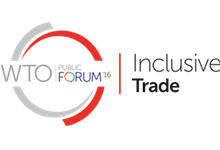Inclusive digital trade and sustainable development: Exploring creative solutions and ways forward
29 Sep 2016 11:00h
[Read more session reports and live updates from the 2016 WTO Public Forum.]
This session, organised by DiploFoundation and the Geneva Internet Platform (GIP), explored the avenues for meaningful involvement, and concrete actions for achieving inclusive digital trade. Jovan Kurbalija, Director of DiploFoundation and Head of the Geneva Internet Platform, introduced the GIP, which works towards a more inclusive approach to digital policy in Geneva, reduces ‘translation issues’ from one policy domain into another, and connects the dots between different issues.
Marilia Maciel, Digital Policy Senior Researcher at DiploFoundation, started the session with a Kahoot Quiz, testing the audience’s knowledge with eight questions about digital trade. The conference room quickly grew competitive with the prospect of winning a prize.
After the quiz, Tomas Lamanauskas, Group Director Public Policy at Vimpelcom, talked about how to enable sustainable development goals (SDGs) from the perspective of a ‘digital opportunities provider’. Lamanauskas explained that many connectivity providers, such as mobile phone operators, are moving into the domain of digital platforms. As such, Vimpelcom can be seen as an intermediary that enables the creation of services. These enabling platforms make it cheaper, faster, and easier to launch a service, and thereby provide an element of inclusion that can feed into the SDGs.
On the issue of trade, Lamanauskas noted that international data flows are an increasingly important form of trade, and may dominate trade flows in the future. Yet, although connectivity is rising, legal frameworks are lagging behind. Data protection laws are lacking in more than half of the countries, while e-commerce requires a stable and clear regulatory environment. Lamanauskas furthermore emphasised that lessons need to be drawn from the past when assessing how to frame digital trade policies. A proper regulatory framework should mitigate risk, while also ‘riding the waves of innovation’.
Michael Kende, Senior Fellow at Internet Society, echoed Lamanauskas’ emphasis on seeing the Internet as a platform ‘to create and produce, rather than just consume’. Yet, although the opportunities seem to be borderless when going online, he pointed at several important barriers to digital trade. For instance, application stores are not available in many sub-Saharan countries, which not only means that downloading applications is made impossible, but that there are also significant limitations in creating applications. This forms a direct obstacle to inclusion in the global trade system. Therefore, there is an important dichotomy between the possibilities of digital technologies and the reality of the digital revolution.
Raymond Saner, Director of the Trade Policy and Governance Programme at the Centre for Socio-Eco-Nomic Development (CSEND), focused on how digital trade can help making trade sustainable and equitable. Although traditional behavioural economics assumes that individuals make rational decisions with all available market information, in reality, this information is not available in most economies. Information and communication technologies (ICTs) can greatly improve this information asymmetry, which can particularly benefit developing countries. Saner provided several examples related to SDG 2 – to end hunger and achieve food security – and highlighted how ICTs can work towards social and economic development in this area. Furthermore, he provided several concrete examples of how the international community can use ICTs to solve food security issues internationally.
Next, Nick Ashton-Hart, Consultant in International Internet Policy and Associate Follow at the Geneva Centre for Security Policy, provided some examples of trade obstacles that obstruct Internet adoption. For example, customs, tarrifs, and taxes on the import of hardware and services make it significantly more difficult to bring technology where it is needed. Furthermore, even if there is connectivity, there are obstacles to optimally using the Internet to buy and sell. For example, there might be regulatory barriers to obtaining an online banking application.
The ultimate effectiveness depends on a ‘whole chain of things that has to work’, from national ministries to international institutions. The WTO should set the basic rules that allows for this chain to work, Ashton-Hart notes. Although for some countries making international e-commerce rules is not yet a priority – as they might have a low level of digital adoption – there should still be an effort to move towards agreements, by providing incentives that can improve the conditions for all those involved. In negotiations, ‘if there is not something for everyone, there won’t be anything for anyone’, pondered Ashton-Hart. It is important to assist developing countries evolve towards effective legislation, once more of their citizens get connected.
Antonio Gambardella, Director of FongIT, operates a platform that provides incubation and financing to startups. He emphasised the enormous market power of companies like Google, Apple, Microsoft, and Facebook, which are largely ‘controlling innovation today and trying to control innovation in the future’. Gambardella stressed that this goes against inclusivity, and is not a sustainable phenomenon. Furthermore, he highlighted the importance of privacy, the important role of governments to protect data, and the potential of new technologies, such as blockchain.
In response to Gambardella’s argument, Lamanauskas noted that we need to approach the issue as a trade-off. The technology platforms operated by the big tech companies allow individuals to easily start their own business; yet, by not building everything themselves, they relinquish some of the control. The question then becomes: ‘How to create scalable systems with sufficient control?’. Gambardella responded that, in order to mitigate these effects, there needs to be more awareness about what these platforms do when offering services ‘for free’.
by Barbara Rosen Jacobson
Related event

